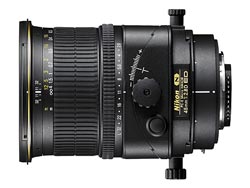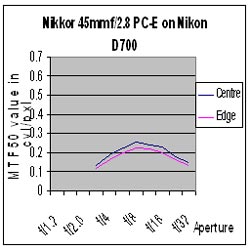Nikon PC-E Micro Nikkor 45mm f/2.8D ED
Nikon PC-E Micro Nikkor 45mm f/2.8D ED: Specification:
- Focal length: 45mm
- Maximum aperture: f/2.8
- Minimum aperture: f/32
- Lens construction: 9 elements in 8 groups (with one ED glass element)
- Picture angle: 51° (maximum 66° when fully shifted)
- Closest focus distance: 0.253 m
- Maximum reproduction ratio: 1/2
- No. of diaphragm blades: 9 (rounded)
- Filter/attachment size: 77mm
- Diameter x length (extension from lens mount): Approx. 82.5x112mm
- Weight: Approx. 740g
- Supplied accessories: 77mm Snap-on Front Lens Cap LC-77, Rear Lens Cap LF-1, Bayonet Hood HB-43, Flexible Lens Pouch CL-1120
Nikon PC-E Micro Nikkor 45mm f/2.8D ED: Build and Handling
One of two new specialist lenses, this PC-E 45mm optic is just that, a specialised lens that is not for the faint hearted, an d to that end it comes with a comprehensive manual for a modern lens. This makes a total of three PC-E lenses along with the 24mm and 85mm versions. The advances over older models include Nikon's new Nano-coating of the optical elements and auto-aperture for compatible camera bodies as well as improved optical performance.
d to that end it comes with a comprehensive manual for a modern lens. This makes a total of three PC-E lenses along with the 24mm and 85mm versions. The advances over older models include Nikon's new Nano-coating of the optical elements and auto-aperture for compatible camera bodies as well as improved optical performance.
The lens is capable of tilting, shifting and rotating in order to adjust the perspective and to help control the plane of the depth-of-field. Because of these adjustments, the lens does not offer any autofocus capabilities although a lens of this nature requires careful manual focusing anyway.
The manual does warn you that setting the lens off centre can cause you to pinch your fingers if care is not taken, especially in the shift mode. This is due not just to the movement of the optics but also the numerous knobs that stick out of the lens body that enable the adjustments and locking off that the optic is capable of.
As you would expect from a Pro standard lens from Nikon, the build quality is excellent with all of those knobs and buttons, along with the slide and tilt mechanisms, working smoothly and efficiently. There is a mild click as the lens comes back into line on both adjustments and the rotation mechanism has similar presets at 30° intervals with locks at the four 90° points. All of the graduation marks are engraved into the body of the lens as well as being painted.
 Image taken at f/2.8. |
Nikon PC-E Micro Nikkor 45mm f/2.8D ED: Performance
This lens is not designed for speed and to make use of its capabilities it demands use on a tripod. Once there it really comes into its own with architecture and landscapes being its forte. Don't forget the Micro in its name either, where its ability to focus down to a reproduction ratio of 1:2 and the plane of sharp focus can be optimised for the subject. So it's just as happy in the studio doing product and food photography. At its straight setting, there is zero distortion, either barrel or pincushion, an important point where any perspective control is applied, an operation that would amplify the phenomenon. ED glass is used to minimise aberrations and the nine blade rounded diaphragm stops the lens down to an aperture of f/32. Designed to compliment the new FX format cameras, the lens is designed to cover the full frame although some vignetting is visible when the extremes of the adjustments are used. It's not severe though and can easily be overcome in software. One advantage with the latest cameras sporting liveview is that, in the liveview mode, stopping the lens down with the appropriate button on the lens, focus can be checked without the loss of light normally associated with depth-of-field previews, as the liveview compensates for the loss of light, giving a normally brightened view on the LCD screen, which can then be zoomed in for the focus check.
 Image taken at f8. |
Resolution, as you might expect, is superb and edge performance is virtually the same as the centre of the image. In the camera, and once the resultant files are put through Imatest, the aperture reads -1/3rd stop throughout the aperture range, performance peaking at f/11, but even the drop-off through diffraction is not severe.
The one anomaly that is measurable, and even that stays within acceptable levels, is chromatic aberration, which nears the acceptable threshold only at the extreme edges on a full frame body.
Contrast is good to excellent throughout the aperture range and across the full extent of the frame.

Nikon PC-E Micro Nikkor 45mm f/2.8D ED: Verdict
Improvements over the existing optics are significant in both the operational and optical areas while the added focal length in this new range of PC-E lenses will be most welcomed by some. The ‘E' in the PC-E title stands for the Electronic operation of the aperture, making use of the lens a lot simpler than the older fully manual versions.
Being a specialist lens, the optic doesn't come cheap but, for those with a need for this kind of lens, this one is certainly a cracker.
Nikon PC-E Micro Nikkor 45mm f/2.8D ED: Plus points
![]() Easier to use than previous models
Easier to use than previous models
![]() Good range of adjustments
Good range of adjustments
![]() Excellent image and edge performance, even on full frame sensors
Excellent image and edge performance, even on full frame sensors
Nikon PC-E Micro Nikkor 45mm f/2.8D ED: Minus points
![]() Limited usefulness, although it is a specialist optic
Limited usefulness, although it is a specialist optic
![]() Costly for occasional use
Costly for occasional use
HANDLING
![]()
PERFORMANCE
![]()
OVERALL
![]()
The Nikon PC-E Micro Nikkor 45mm f/2.8D ED is available from Warehouse Express here.
Tested by Ian Andrews www.thewildlifestudio.com
Add your message
Please login here or if you've not registered, you can register here. Registering is safe, quick and free.
photodo Stats
428 MTF tests
74 in-depth photodo reviews
100+ users join each day
Help the lens community by reviewing or rating a lens today via our lens search
Latest Lens Reviews
- Chinon 28mm f/2.8 Vintage Lens Review
- Canon EF 70-200mm f/4L IS II USM Lens Review
- Samyang AF 85mm f/1.4 EF Review
- Sigma 70mm f/2.8 DG Macro Art Review
- Samyang AF 24mm f/2.8 FE Review
- Meike 50mm f/1.7 Review
- Tamron 70-210mm f/4 Di VC USD Review
- Lensbaby Burnside 35mm f/2.8 Review
- Asahi Super Takumar 50mm f/1.4 Review
- Asahi Super-Multi-Coated Takumar 135mm f/3.5 Review


